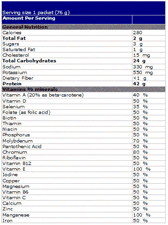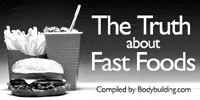However, I do know that as individuals add more and more complexity to a given task, their chances of achieving the desired outcome are greatly lessened. Yes, "analysis paralysis" begins to set in and worrying about minutia does nothing more than detract from their progress.
I don't want you to fall into that trap, and that's precisely the reason I'm writing this article - to give you the fundamentals, the basics, the nuts and bolts of effective dieting - fundamentals and basics that account for more than 90% of the progress you make. Losing fat mass doesn't have to be hard; let's not make it that way!

The Arithmetic Of Dieting

Simply put, if you want to lose fat mass, you have to burn more calories than you consume daily; a caloric deficit is in order. If you fail to do this, your progress will be close to nonexistent. But how much of a caloric deficit are we talking here?
Well, since most people's maintenance calorie intake (the intake at which you neither gain nor lose weight) can be calculated by multiplying their lean body mass (LBM; your lean body mass is your total weight minus your fat weight) by 15, a good place to start when dieting is 12 x LBM. This will allow you to lose approximately 1.5-2 lbs weekly without sacrificing your hard earned muscle mass.
 |
What Does Lean Body Mass Mean? Everything in the body except for fat, including bone, organs, skin, nails and all body tissue including muscle. Approximately 50-60% of lean body mass is water. Lean body mass refers to the weight of the body minus the fat content, or, in other words, the body mass without the fat. |
 |
 |
||
If you aren't in the 1.5-2 lb range, then adjust your caloric intake accordingly (i.e. decreasing it if you aren't losing weight fast enough or increase it if you are losing weight too rapidly).

Counting Calories & Reading Food Labels

The only way you can be certain of the energy you are consuming daily is by counting the calories you ingest. Now, I know that may seem like a hassle, but it's really not all that difficult. Just follow along and you'll quickly realize the below is a very simple, yet very effective method to track your energy intake.
First, we need to talk about the three primary sources from where we consume our daily energy: protein, carbohydrates, and fat. These are known as the macronutrients.
Their Caloric Value Is As Follows:
-
Protein: 4 cal/g
Carbohydrates: 4 cal/g
Fat: 9 cal/g
As you can see, a gram of fat contains just over twice the energy of both protein and carbohydrates. Because of this and the false belief that consuming fat leads to accumulation of body fat, fat has been labeled as a dietary evil.
Despite its negative connotation, substantial fat intake is necessary to promote optimal hormone levels, central nervous system function, and overall health. Consumption of certain fats have even been correlated to a loss in fat mass! Therefore, regardless of your goal, I recommend that fats compose 25% of your daily calories.
Let's take, for example, John. John weighs 185 lbs and is 10% body fat, therefore his LBM is 185 x .90 or 166.5 lbs. To calculate John's daily caloric needs, we multiply this number by 12 and get approximately 2000 calories daily. As mentioned earlier 25% of these calories will be derived from fat. 2000 x .25 = 500 calories from fat. Since fat is 9 cal/g, you simply divide the total calories from fat by 9 to give you your daily gram total. For John, this would be 500/9 or ~56 grams of fat daily.
Now, I also recommend that individuals consume 1.25g of protein per lb of lean body mass to promote recovery from workouts and retention of LBM. We already established that John's LBM is 166.5 lbs. Now, to get his daily protein intake, we simply multiply his LBM by 1.25, which equals roughly 208g of protein daily. Since protein is 4 cal/g, John will be consuming 832 calories (208g of protein x 4cal/g) from protein daily.
 |
||||
 |
|
 |
||
 |
||||
NOTE: An easy way to access your body fat is via skinfold calipers. I recommend the digital skinfold calipers by FatTrack; it's a worthy investment considering you'll need to frequently track your body fat percentage. Also, by learning how to take these measurements yourself, you get the most accurate reading. This is because you use the same measurer (you), the same calipers (yours), and the same method (3-site) every time you measure.
The last macronutrient to calculate is carbohydrates. This is done by simply subtracting the calories already accounted for by fat and protein from the daily total. 2000 (daily total) - 832 (calories from protein) - 500 (calories from fat) = 668 calories from carbohydrates. Since carbohydrates are 4 cal/g, this individual will be consuming 167g (668/4) of carbohydrates daily.
Now we have established John's daily gram needs for each macronutrient. Here they are again:
-
Protein: 208g
Carbohydrates: 167g
Fat: 56g
Determine Your Daily Macronutrient Needs! 
 |
|||
 |
|
 |
|
 |
|||
The cool thing about converting everything to grams is that you no longer have to worry about counting calories (see, I told you I'd make this simple). You simply count the grams of each macronutrient you consume. This makes things even easier considering the way our food labels are organized.
To illustrate this, let's take a look at John's breakfast and obtain the figures we need from the respective food labels.
- 1 packet/serving of a quality whey/casein blend Meal Replacement Powder
- 1 cup of dry oatmeal
John added hot water to the oatmeal and then stirred in the Meal Replacement Powder for a yummy, nutritious breakfast. Now, let's take a look at the food labels below to get the macronutrient content of each product.
MRP:
Oatmeal:
The first thing that needs to be considered when reading any food or supplement label is the serving size, usually located at the top of the label. Because all the information on the label pertains to a specific amount of the product, serving size is critical. As you can see, one packet of the MRP constitutes one serving.
Since John consumed one packet, he simply needs to record the macronutrient information given on the label (these figures easily stand out as they are in bold, and usually appear in the order of F-C-P). One serving of the MRP contains 42 grams of protein, 25 grams of carbohydrates, and 2 grams of fat.
As for the oatmeal, the serving size is 1/2 cup dry. John consumed double this amount and needs to double the macronutrient information. One serving of dry oatmeal contains 5 grams of protein, 27 grams of carbohydrates, and 3 grams of fat. Two servings would then contain 10 grams of protein, 54 grams of carbohydrates, and 6 grams of fat.
After adding the gram numbers from the MRP and oatmeal together, we get 52 grams of protein, 79 grams of carbohydrates, and 8 grams of fat.
Essentially, you would add up and record the grams of each macronutrient consumed at each meal. At the end of the day, the goal is to come within 5 grams of your daily need for each macronutrient.

Food Choices & Macronutrient Combinations

Obviously, you're not going to get the physique of your dreams by eating cookies and candy bars. Contrary to popular belief, a calorie is not a calorie.
Different energy substrates, the various types and forms of each substrate, and combinations of these substrates are all metabolized differently by the body and have a different overall effect on body composition. Below is a list of acceptable food choices for each macronutrient:
-
Protein:
The bulk of the protein that you consume should be from complete sources - sources that contain the entire amino acid chain. These include chicken breast, turkey breast, fish, lean pork, lean red meat, fresh ham, eggs (whole or whites), milk, cottage cheese, and milk protein powders ( whey and casein).
If you are a male, avoid soy protein in large quantities because of its estrogen-like properties. If you are uncertain as to whether a product contains soy protein, read through the list of ingredients on the product label.
 |
||||
 |
|
 |
||
 |
||||
Carbohydrates:
The bulk of carbs in your diet should be from fibrous, unredefined sources. These include oatmeal, oat bran, lentils, beans, 100% whole-wheat bread, whole-wheat pasta, red potatoes, yams, greens, most other vegetables, and fruit. Simple sugars should be limited to special circumstances, which will be addressed later.
Fats:
The bulk of fat in your diet should be primarily unsaturated and in the form of essential fatty acids (EFAs). These include flax seeds and/or flax seed oil, sunflower seeds and/or sunflower seed oil, fish oil (from fish or as capsules), hemp oil, olive oil, raw nuts, all natural peanut butter, and avocados.
Consuming some saturated fat from cheese, red meat, and whole eggs is both fine and beneficial as these fats have the greatest effect on anabolic hormone levels. Trans-fatty acids should be avoided at all costs; consumption of these fats have been shown to have the highest correlation to heart disease, decrease "good" cholesterol (HDL) levels, and increase "bad" cholesterol (LDL) levels [1,2,3,4,5]. Therefore, avoid all fried foods and any product that contains "hydrogenated" or "partially hydrogenated" oils in its list of ingredients.
 |
||||
 |
|
 |
||
 |
||||
Now that you know what to eat, let's talk about when to eat it. Regardless of your goal, I recommend that you stick to the macronutrient combination rules recommended by exercise and nutritional biochemist John M. Berardi. John recommends that 3 of your daily meals consist of protein and fat (P + F) w/ minimal carbohydrates and the other three meals be comprised of protein and carbohydrates (P + C) with minimal fat.
In other words, the object is to never combine carbohydrates and fats in significant amounts in a single meal. Why? Well, although insulin's primary function is to shuttle glucose into skeletal muscle, it also carries many other nutrients to their storage sites; this includes lipids (fat).
Carbohydrate ingestion stimulates a large insulin secretion and fat ingestion raises blood lipid levels; therefore, the combination is a no-no. By avoiding the above, you will be able to eat more while still achieving the same rate of fat loss.
 |
What Is A Blood Lipid? A blanket term used to describe the different types of cholesterol (LDL, HDL, and VLDL) and fat (triglycerides) in the blood. |
 |
 |
||
So, on training days, your three P + C meals should be breakfast, your pre/post workout shake, and a whole food meal about 2 hours after your training. On non-training days, your first three meals should be P + C and your final three would then be P + F.

The Coveted Cheat Day

No diet that claims to be simple would be complete without allowing for some periodic indulging. And since this diet claims just that, treat yourself once a week on Saturday or Sunday to those foods you've been salivating over all week long. Don't worry about counting calories, don't worry about eating "right," just enjoy it.
On the same note, don't eat everything in site just because you "can," but rather be a bit more conservative while still eating those foods you crave. This will not only allow for a much needed psychological break from your weekly dieting and exercise program, but it also has quite a few nifty physiological benefits to keep the fat coming off as you return to your regular diet the following day.

The Other Side Of The Coin

In order to optimize the results you receive from your dieting efforts, you should also be exercising regularly. Below is a training schedule that is consistent with the information presented in this article (i.e. simplistic, yet effective).
-
Monday:
Chest, Biceps, and Calves
Tuesday:
30 minutes of moderate intensity cardio
Wednesday:
Quads, Back, and Shoulders
Thursday:
30 minutes of moderate intensity cardio
Friday:
Hamstrings and Triceps
Saturday:
30 minutes of moderate intensity cardio
Sunday:
Off

Conclusion

Dieting doesn't have to be extremely overbearing and meticulous to be effective. By following the simple advice outlined in this article, you will be well on your way to dropping fat, feeling good, and looking great! Whoever came up with the acronym K.I.S.S. was one smart, smart man.
About The Author
Joel Marion, Founder and Editor-in-Chief of Rugged Magazine (www.ruggedmag.com) and Body-for-Life 2001 Grand Champion, is a NSCA Certified Personal Trainer double majoring in Exercise Science and Physical Education at The College of New Jersey. His main desire is to aid others in the building of their best bodies through sound advice in the areas of training and nutrition. He can be contacted at joel_marion@ruggedmag.com.
References
- Aro, A., et al. Stearic acid, trans fatty acids, and dairy fat: effects on serum and lipoprotein lipids, apolipoproteins, lipoprotein (a), and lipid transfer proteins in healthy subjects. Am. J. Clin. Nutri., 65: 1419, 1997.
- ASCN/AIN Task Force on Trans Fatty Acids: Position paper on trans fatty acids. Am. J. Clin. Nutri., 63:663, 1996.
- Hunger, JE, and Applewhite, T.H. Reassessment of trans fatty acid availability in the U.S. Am. J. Clin. Nutri., 54:363, 1991.
- Troisi, R., et al. Trans-fatty acid intake in relation to serum lipid concentrations in adult men. Am. J. clin. Nutri., 56:1019, 1992.
- Holub, B. Fats, the good, the bad, and the ugly. Annual Ontario Exercise Physiology Conference. Barrie, Ontario, 2002.
- Myoplex Nutrition Facts






